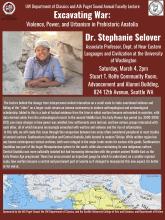UW Department of Classics and AIA Puget Sound Annual Faculty Lecture
"Excavating War: Violence, Power, and Urbanism in Prehistoric Anatolia"
Dr. Stephanie Selover
Associate Professor, Dept. of Middle Eastern Languages and Cultures at the University of Washington
The factors behind the change from interpersonal violent interaction on a small scale to state-sanctioned violence and killing of the “other” on a larger scale remain an intense controversy in modern anthropological and archaeological scholarship. Added to this is a lack of textual evidence from the time in which warfare became entrenched in societies, with data derived solely from the archaeological record. In the ancient Middle East, the Early Bronze Age period (ca. 3000-2000 BCE) saw many changes in how power was wielded, how settlements were laid out, and how various groups interacted with each other, all of which became increasingly enmeshed with warfare and violence and the rise of urbanization.
In this talk, we will study this issue through the comparison between two areas often considered peripheral in most studies of ancient warfare: Southeastern Anatolian and Central Anatolia, both located in modern Türkiye. While neither region has any known contemporary textual archives, both were integral in the major trade routes for various elite goods. Southeastern Anatolia was part of the larger Mesopotamian sphere to the south, while also maintaining its own indigenous culture. Central Anatolia was more culturally isolated but had increasing interaction with the greater ancient Middle East as the Early Bronze Age progressed. These two areas present an important gauge by which to understand, on a smaller regional scale, how warfare became a central and permanent part of society as it changed to incorporate this new aspect, for better or for worse.
